|
|
Created/dedicated as per personal communication with Holly, August 14, 2013
Updated as per BAMONA, August 15, 2013
Updated as per James P. Tuttle's The Hawk Moths of North America, August 15, 2013
Updated as per personal communication with Krystal Kinney and Daniel Marlos (Smerinthus saliceti), July 15, 2014
Updated as per personal communication with Jennifer Rosta (Pachysphinx occidentalis), April 5-6; April 7, 2015
Updated as per personal communication with Sgt. Allen Ray Hardison III (Hyles lineata, Fort Irwin), April 23-24, 2017
|
San Bernardino County
Sphingidae
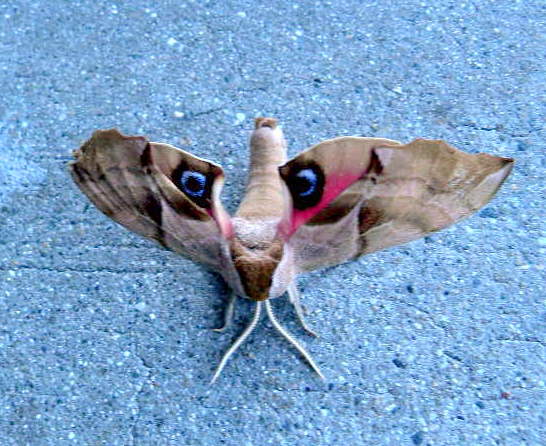
Smerinthus ophthalmica, San Bernardino County, California,
August 14, 2013, courtesy of Holly.
Thirty-three Sphingidae species are listed on BAMONA (2013) for California. Not all of the species are reported by BAMONA
or anticipated in San Bernardino County. Nineteen species have been reported in San Bernardino County on the BAMONA website as of August 15, 2013.
It is hoped that this checklist, with the thumbnails and notes, will help you quickly identify the moths you have encountered or are likely to encounter.
A WO" after the species name indicates that I have no confirmed reports of this species in San Bernardino County, but I
(William Oehlke) expect that this moth may be present.
A BAMONA indicates the moth is reported on the BAMONA website and/or in Moths of Western
North America, #2. Distribution of Sphingidae of Western North America, revised,
an excellent little booklet available through Paul Opler.
This page is inspired by and dedicated to Holly. Holly sent me the image of the Smerinthus ophthalmica moth at the top of the page.
Holly writes, "Smerinthus cerisyi?
"Moth in the San Bernardino National Forest/Mountains, across the street from Lake Gregory, Crestline, California, USA (San Bernardino County)"
I reply, "Holly,
"If you had asked me about two months ago, I would have written Smerinthus cerisyi, but I have to update my Sphingidae webpages, replacing
Smerinthus cerisyi with Smerinthus ophthlamica for all the look-a-likes west of the Continental Divide.
So this one is S. ophthalmica.
"This is all based on a late 2011 publication that I only recently read.
"I wish permission to post your image, credited to you, as ophthalmica on the San Bernardino page?"
Many thanks to Daniel Marlos and Krystal Kinney for the following submission:
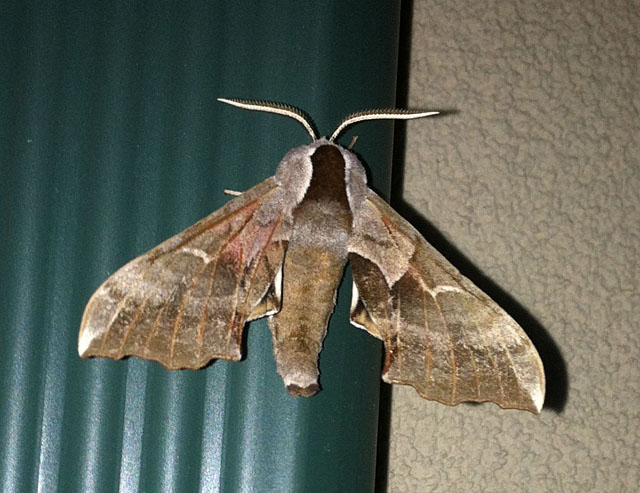
Smerinthus saliceti male, Lake Arrowhead, San Bernardino County, California,
July 8, 2014, courtesy of Krystal Kinney, via Daniel Marlos of What's that Bug;
identification by Bill Oehlke.
Please help me develop this list with improved, documented accuracy by sending sightings (species, date, location), preferably with an
image, via email to Bill Oehlke.
Please also report your sightings to BAMONA, an excellent online resource.
Many thanks to Jennifer Rosta who sends the following images of Pachysphinx occidentalis. The female emerged from a subterranean chamber on April 5,
and climbed up the side of the house. That night she called in a male via a pheromone scent released into night sky, and Jennifer took the picture of both male
and female in copula on April 6.
The pair separated on the night of April 6 and this morning, April 7, 2015, only the famale remains. If she does not get eaten by a bird or other predator, she
will fly away, under cover of darkness, to disperse the 200-300 translucent-green egg-payload she is carrying in her swollen abdomen. She will lay the eggs in
small groups of 4-8 on poplar or willow foliage over the next 5-7 nights.
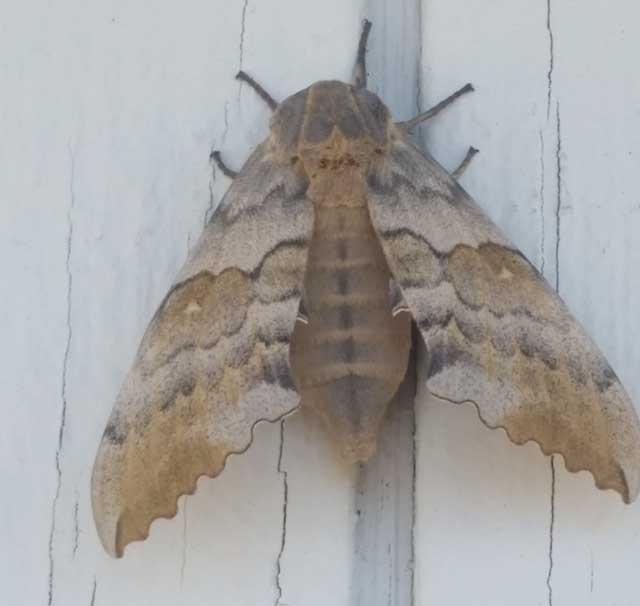
Pachysphinx occidentalis female, Phelan, San Bernardino County, California,
April 5, 2015, courtesy of Jennifer Rosta.
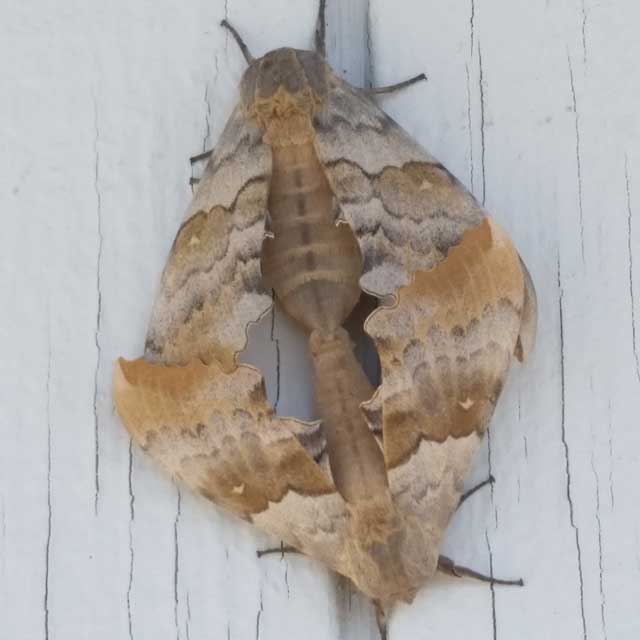
Pachysphinx occidentalis in copula, Phelan, San Bernardino County, California,
April 6, 2015, courtesy of Jennifer Rosta.
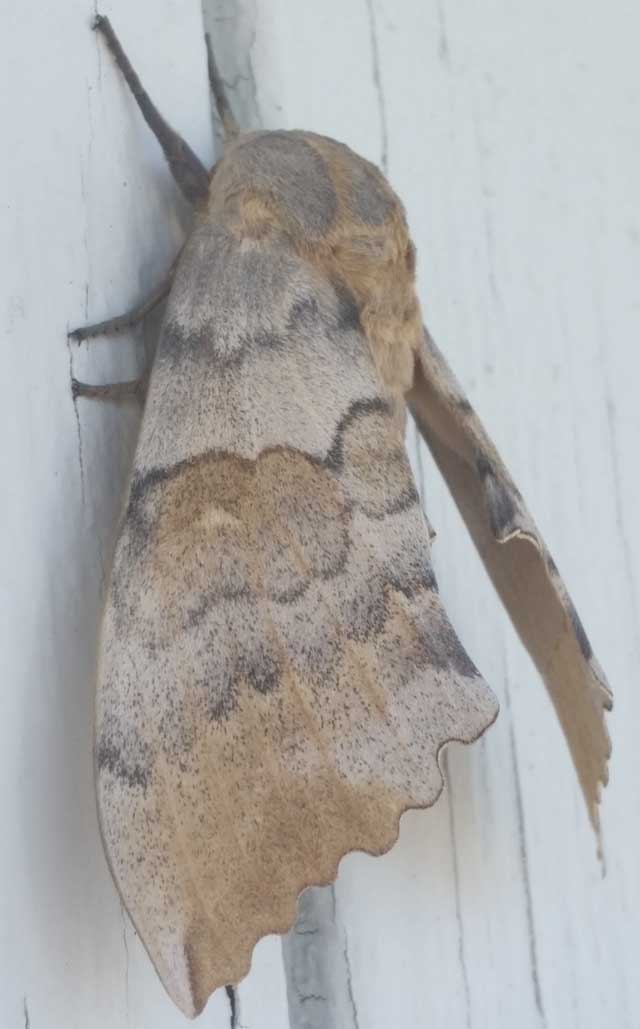
Pachysphinx occidentalis post copula, Phelan, San Bernardino County, California,
April 7, 2015, courtesy of Jennifer Rosta.
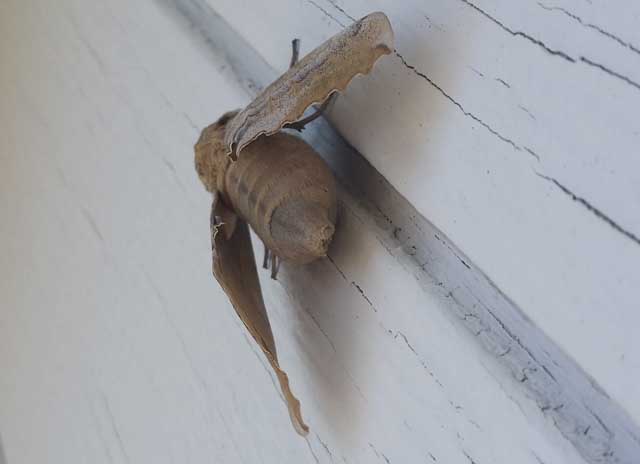
Pachysphinx occidentalis swollen abdomen, Phelan, San Bernardino County, California,
April 7, 2015, courtesy of Jennifer Rosta.
Visit San Bernardino: Sphingidae larvae.
Visit California Catocala: Underwing Moths.
Sphinginae subfamily
Sphingini tribe:
 |
Agrius cingulata WO:
This species is enountered in Riverside County and in other
southern California counties.
The moth is a very strong flier and
is frequently encountered far north of its usual range.
|
 |
Manduca quinquemaculatus
BAMONA, the Five-spotted Hawkmoth:
This large bodied moth flies in tobacco fields and vegetable gardens
(potatoes, tomatoes) and wherever host plants are found. |
 |
Manduca rustica
WO, the Rustic Sphinx:
This species is recorded in nearby Riverside County. I would not
be surprised to get reports although San Bernardino would be the northern
limit of its range in California. Look for three large yellow spots
on each side of the abdomen.
|
 |
Manduca sexta BAMONA, the Carolina Sphinx:
This species is recorded in Riverside County.
If you grow tomatoes, you have probably encountered it.
Larvae get very large and can strip a tomato plant. |
 |
Sphinx chersis BAMONA, the Northern Ash
Sphinx or Great Ash Sphinx
The upperside of the forewing is soft dark gray to blue-gray with a series of black dashes,
one of which reaches the wing tip. |
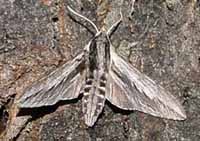 |
Sphinx dollii
BAMONA,
Doll's sphinx: (Wing span: 1 3/4 - 2 1/2 inches (4.5 - 6.3 cm)),
flies in arid brushlands and desert foothills from Nevada and
southern California east through Utah,
Arizona, Colorado, and New Mexico to Oklahoma and Texas.
|
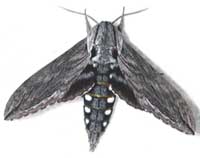 |
Sphinx libocedrus
BAMONA,
the Incense Cedar Sphinx: The upperside of the forewing is pale blue-gray to dark gray with a black dash reaching the wing tip and
a white stripe along the lower outer margin.
The upperside of the hindwing is black with two diffuse white
bands, the upper one being practically non-existent.
|
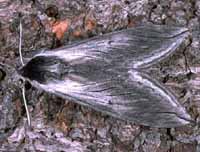 |
Sphinx perelegans BAMONA, the Elegant Sphinx:
Sphinx perelegans adults fly in montane woodlands and mixed chaparral-type vegetation as a single brood
in the north, with adults mainly on the wing in June and July.
It flies from dusk until after midnight. |
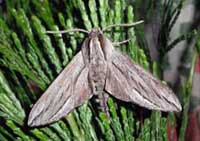 |
This species is reported in Riverside County.
Adults fly as a single brood in the desert and in pinyon-juniper
woodland from May to August. |
 |
Sphinx vashti
BAMONA, the Snowberry Sphinx:
Snowberry Sphinx adults fly as a single brood in montane woodlands and along prairie
streamcourses from April to August.
The upperside of the forewing has a narrow black subterminal line
bordered by a white inverted V-shaped line on the outside, and a
black line at the apex. |
Smerinthini Tribe:
 |
This one is quite similar to Pachysphinx modesta, with modesta
being smaller and darker.
Moths should be on the wing from June-August.
|
Pachysphinx occidentalis Phelan, April 5, 2015, courtesy of Jennifer Rosta.
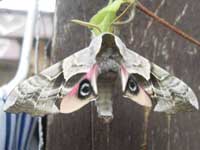 | Larvae feed on poplars, aspen and willows.
Note different shape of double arced forewing pm line compared to the straighter pm line of cerisyi, directly above.
S. ophthalmica has smoother scalloping of the fw outer margin.
|
Smerinthus opthalmica, Smerinthus cerisyi?
moth in the San Bernardino National Forest/Mountains, across the street from Lake Gregory
Crestline, California, USA (San Bernardino county)
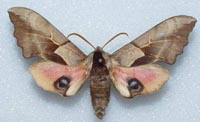 |
Smerinthus saliceti
WO/KK, the Salicet
Sphinx, flies in valleys and along streamsides from Mexico City north
to west Texas, southern Arizona, and extreme southern California.
Larvae feed on poplars and willows.
Flight would be from late April-September, probably as a double brood.
|
Smerinthus saliceti male, Lake Arrowhead, July 8, 2014, courtesy of Krystal Kinney
Macroglossinae subfamily
Dilophonotini Tribe:
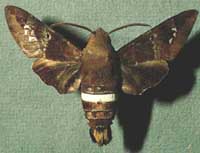 |
The body is dark brown with a wide white
band across the abdomen. Wings are dark brown. The forewing has a
black cell spot and 3 white spots near the pale brown marginal
area. |
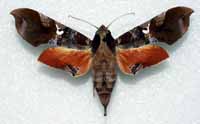 |
This species is reddish, has falcate wings
and flies after midnight.
It is very questionable for San Bernardino County, but may stray into
that area. |
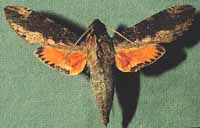 |
Erinnyis crameri, the Cramer's Sphinx, WO:
This species is more likely to occur as an occasional stray rather than as a breeding resident.
As a migrant stray it would be seen later in the season, July-August. |
 |
Erinnyis ello, the Ello Sphinx, WO
The abdomen has very distinct gray and black bands.
Adults nectar at dusk so you may see them in the garden at that time. |
 |
Erinnyis obscura, the Obscure Sphinx, BAMONA
During the night adults nectar at flowers, including bouncing bet
(Saponaria officinalis) and Asystasia gangetica beginning at dusk.
July and August are flight times in the southern states.
|
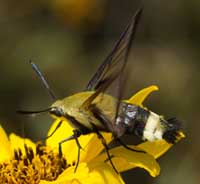 |
Hemaris thetis BAMONA, the Thetis Clearwing or Bee Hawk Moth,
The moth flies along forest edges and in meadows, gardens and
brushy fields. Day-flying adults nectar at lantana, dwarf bush honeysuckle,
snowberry, orange hawkweed, thistles, lilac, Canada violet, etc.
|
Hemaris thetis, Cleveland National Park, July 5, 2013, 2000ft, Doug Galasko
Philampelini Tribe:
 |
Eumorpha achemon BAMONA,
the Achemon Sphinx:
This moth is reported for Riverside County, and should be fairly
common.
Fight would be from June to August. Larvae feed on grape foliage. |
 |
Eumorpha fasciata BAMONA, the Banded Sphinx:
This moth is a very strong flier and is often reported far north of
its normal range. It would be a rare stray to Riverside if it is at all present.
|
Macroglossini Tribe:
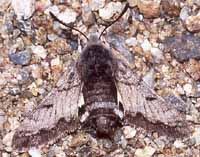 |
Euproserpinus phaeton,
the Phaeton Primrose Sphinx, BAMONA
Adults nectar at flowers during the warm parts of the day.
Euproserpinus phaeton adults fly swiftly and close to the ground over
dry washes and flat areas in deserts as a single brood from
February-April. |
 |
Hyles lineata
BAMONA/SARHIII, White-lined Sphinx.
Adults usually fly at dusk, during the night, at dawn, and during the
day. Moths nectar at salvia and other flowers and oviposit on
Epilobium cana (California fuchsia) and Hooker's Evening
Primrose, and others. |
Hyles lineata, Fort Irwin, April 23-24, Sgt. Allen Ray Hardison III
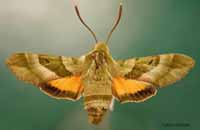 |
Proserpinus clarkiae BAMONA, Clark's Sphinx.
Adults fly in the afternoon from April-June in oak woodland and
pine-oak woodland in foothills, nectaring from chia, heartleaf
milkweed, golden currant, bluedicks, fairyfans, vetches,
thistles, hedgenettles, etc. |
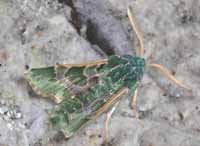 |
Proserpinus lucidus BAMONA, the Pacific Green
Sphinx Moth or Bear SphinxThis species is confirmed in Riverside
County.
It tends to be an late winter-early spring flier, on the
wing in the early evening. It comes to lights at night. |
|
|
Enjoy some of nature's wonderments, giant silk moth cocoons.
These cocoons are for sale winter and fall. Beautiful Saturniidae moths will emerge the following spring and summer.
Read Actias luna rearing article. Additional online help available.
Use your browser "Back" button to return to the previous page.
This page is brought to you by Bill Oehlke and the
WLSS. Pages are on space rented from Bizland. If you would like to become a "Patron of the Sphingidae Site", contact Bill.
Please send sightings/images to Bill. I will do my best to respond to requests for identification help.
 | 
Show appreciation for this site by clicking on flashing butterfly to the left.
The link will take you to a page with links to many insect sites. |






